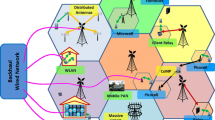Abstract
To provide a comprehensive network access service to wireless users, a network operator may operate different types of wireless networks (such as GPRS, Wi-Fi, HSDPA, UMTS, WiMAX and 3GPP LTE) simultaneously to become a heterogeneous wireless network operator, such as Vodafone and T-Mobile. With convenience of accessing wireless networks, ubiquitous services would stimulate the bandwidth expenditure in the network backbone. Lots of various demanded traffic from heterogeneous access networks may converge toward Internet through the common backbone in the operator. Efficiently utilizing the common backbone can offer a better quality of service to users and maximize the revenues for the operator. To our best knowledge, few studies had ever been made in such a contemporary wireless network environment in the past. In this study, we propose solutions to efficiently allocate the bandwidth for user requests and fully utilize the unused bandwidth in the network backbone owned by the heterogeneous wireless network operator. Our simulation results show that our scheme can increase the utilization of the backbone bandwidth, shorten the request completion time for users and generate more revenue for the operator.









Similar content being viewed by others
References
Lin, Y.-B., & Chlamtac, I. (2001). Wireless and mobile network architectures. New York: Wiley.
“WiMAX forum”, http://www.wimaxforum.org/home/.
“3GPP LTE”, http://www.3gpp.org/article/lte.
Koundourakis, G., Axiotis, D. I., & Theologou, M. (2007). Network-based access selection in composite radio environments. IEEE wireless communications and networking conference, pp. 3877–3883, Mar 2007.
Kim, S., & Varshney, P. K. (2005). Adaptive online bandwidth allocation and reservation for QoS sensitive multimedia networks. Computer Communications, 28(17), 1959–1969.
Yi, D. H., & Kim, J. W. (2008). A revenue-based bandwidth sharing for advance and immediate reservation calls. IEICE-Transactions on Communications, E91-B, 3617–3626.
AlQahtani, S. A. (2007). Resource allocation schemes for UMTS mobile service providers with heterogeneous traffic. IEEE international conference on networks, pp. 107–111, Nov 2007.
“Wireless Network Usage Statistic in Taiwan FY2008”, http://www.twnic.net.tw/download/200307/0808c.doc.
Ameiqeiras, P., Wiqard, J., & Mogensen, P. (2004). Performance of packet scheduling methods with different degree of fairness in UMTS. IEEE vehicular technology conference 2004 fall, Vol. 2, pp. 860–864, Sept 2004.
Fernandez, J. C., Taleb, T., Ansari, N., Hashimoto, K., Kato, N., & Nemoto, Y. (2007). Dynamic QoS negotiation for next generation wireless communications systems. IEEE wireless communications and networking conference, pp. 3227–3231, Mar 2007.
Chen, J.C., McAuley, A., Sarangan, V., Baba, S., & Ohba, Y. (2002). Dynamic service negotiation protocol (DSNP) and wireless DiffServ. IEEE international conference on communications 2002, Vol. 2, pp. 1033–1038, Apr 2002.
Leon-Garcia, A., & Mason, L. G. (2003). Virtual network resource management for next-generation networks. IEEE Communications Magazine, 41(7), 102–109.
Demestichas, P., Papadopoulou, L., Stavroulaki, V., Theologou, M., Vivier, G., & Martinez, G., et al. (2002). Wireless beyond 3G: Managing services and network resources. IEEE Computer, 35(8), 80–82.
Demestichas, P. P., Stavroulaki, V. A. G., Papadopoulou, L. M., Vasilakos, A. V., & Theologou, M. E. (2004). Service configuration and traffic distribution in composite radio environments. IEEE Transactions on Systems, Man, and Cybernetics, Part C: Applications and Reviews, 34(1), 69–81.
Kibria, M. R., Jamalipour, A. (2007). On designing issues of the next generation mobile network. IEEE Network, 21(1), 6–13.
Gopalan, K., Chiueh, T. C., & Lin, Y. J. (2004). Load balancing routing with bandwidth-delay guarantees. IEEE Communications Magazine, 42(6), 108–113.
Song, W., & Zhuang, W. (2009). Multi-service load sharing for resource management in the cellular/WLAN integrated network. IEEE Transactions on Wireless Communications, 8(2), 725–735.
Duan, Z., Zhang, Z. L., Hou, Y. T., & Gao, L. (2004). A core stateless bandwidth broker architecture for scalable support of guaranteed services. IEEE Transactions on Parallel and Distributed Systems, 15(2), 167–182.
Xiao, Y., Chen, C. L. P., & Wang, Y. (2001). Fair bandwidth allocation for multi-class of adaptive multimedia services in wireless/mobile networks. IEEE vehicular technology conference 2001 Spring, Vol. 3, pp. 2081–2085, May 2001.
Dharwadkar, P., Siegel, H. J., & Chong, E. K. P. (2001). A heuristic for dynamic bandwidth allocation with preemption and degradation for prioritized requests. The 21st international conference on distributed computing systems 2001, pp. 547–556, Apr 2001.
Bouras, C., & Stamos, K. (2004). An adaptive admission control algorithm for bandwidth brokers. In Third IEEE international symposium on network computing and applications 2004 (pp. 243–250).
“SIMSCRIPT”, http://www.simscript.com/.
Lindemann, C., Lohmann, M., & Thmmler, A. (2002). Adaptive performance management for universal mobile telecommunications system networks. Computer Networks, 38(4), 477–496.
Author information
Authors and Affiliations
Corresponding author
Rights and permissions
About this article
Cite this article
Leu, JS., Lin, CK. On utilization efficiency of backbone bandwidth for a heterogeneous wireless network operator. Wireless Netw 17, 1595–1604 (2011). https://doi.org/10.1007/s11276-011-0366-3
Published:
Issue Date:
DOI: https://doi.org/10.1007/s11276-011-0366-3




